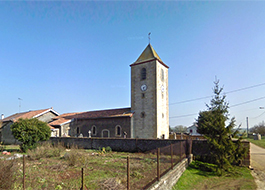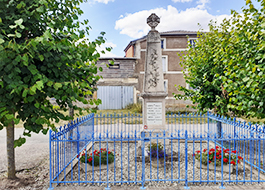Villers-lès-Mangiennes
Durée visite : 15 minutes
Moyen : Pédestre
Le village est cité en 973 dans une charte de donation de Vicfried, évêque de Verdun, en faveur de l’abbaye Saint-Paul. Des moines de l’ordre cistercien, nouvellement fondé, s’installent provisoirement ici en 1142. L’activité forestière et l’agriculture font vivre les 314 habitants, que Villers compte à son apogée en 1850. Il en reste 80 en 2019.
The village is mentioned in 973 in a charter of donation from Vicfried, bishop of Verdun, in favor of the abbey of Saint-Paul. Monks of the newly founded Cistercian order settled here temporarily in 1142. Forestry and agriculture support the 314 inhabitants, which Villers had at its peak in 1850. There are 80 left in 2019.
Das Dorf wird 973 in einer Schenkungsurkunde von Vicfried, Bischof von Verdun, zugunsten der Abtei Saint-Paul erwähnt. Mönche des neugegründeten Zisterzienserordens ließen sich hier 1142 vorübergehend nieder. Forst- und Landwirtschaft unterstützen die 314 Einwohner, die Villers 1850 auf seinem Höhepunkt hatte. 2019 sind es noch 80.
Les points de visites
.
Bâtie entre 1707 et 1767, Saint-Nicolas conserve le l’église primitive un chœur rectangulaire, voûté en arceaux, du XIVe siècle. Une statue du saint éponyme en bois polychrome orne l’autel latéral. Patron de la Lorraine, saint Nicolas est le protecteur des enfants, auxquels il apporte des bonbons dans la nuit du 5 au 6 décembre. Sainte Appoline, patronne des dentistes, le remercie.
Built between 1707 and 1767, Saint-Nicolas retains the primitive church a rectangular choir, vaulted in arches, from the 14th century. A statue of the eponymous saint in polychrome wood adorns the side altar. Patron Saint of Lorraine, Saint Nicolas is the protector of children, to whom he brings sweets on the night of December 5 to 6. Saint Appoline, patroness of dentists, thanks him.
Saint-Nicolas wurde zwischen 1707 und 1767 erbaut und bewahrt die primitive Kirche aus dem 14. Jahrhundert mit einem rechteckigen Chor mit Bögen. Eine Statue des gleichnamigen Heiligen aus farbigem Holz schmückt den Seitenaltar. Der heilige Nikolaus, Schutzpatron von Lothringen, ist der Beschützer der Kinder, denen er in der Nacht vom 5. auf den 6. Dezember Süßigkeiten bringt. Saint Appoline, Patronin der Zahnärzte, dankt ihm.
.
.
Tué oui, Vaincu Jamais ; Sans Peur et Sans Reproche : c’est la devise du 91e Régiment d’infanterie, qui a combattu ici le 10 août 1914. C’est en Meurthe-et-Moselle qu’est tombé pour la France, Albert Brier, de Villers, appartenant au 19e Bataillon de Chasseurs à Pied, le 21 août suivant. En avant toujours, repos ailleurs est la devise de l’unité. Celle-ci a le Manneken-Pis, comme caporal d’honneur depuis 1919.
Killed yes, Defeated Never; Sans Peur et Sans Reproche: this is the motto of the 91st Infantry Regiment, which fought here on August 10, 1914. It was in Meurthe-et-Moselle that Albert Brier, from Villers, fell for France, belonging to the 19th Battalion of Chasseurs à Pied, on the following August 21. Always forward, rest elsewhere is the unit’s motto. This one has the Manneken-Pis, as honorary corporal since 1919.
Getötet ja, besiegt nie; Sans Peur et Sans Reproche: Dies ist das Motto des 91. Infanterieregiments, das hier am 10. August 1914 kämpfte. Es war in Meurthe-et-Moselle, das für Frankreich fiel, Albert Brier aus Villers, der zum 19. Bataillon von gehörte Chasseurs à Pied, am folgenden 21. August. Immer vorwärts, woanders ausruhen ist das Motto der Einheit. Dieser hat den Manneken-Pis als Ehrengefreiten seit 1919.







